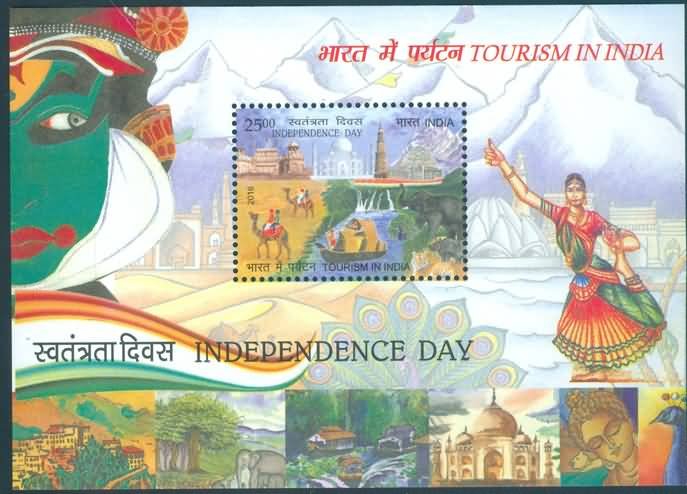Tourism in India

Technical Data
| Date of Issue | August 15, 2016 |
|---|---|
| Denomination | Rs. 25 |
| Quantity | 300,000 |
| Perforation | 13¼ x 13¾ |
| Printer | Security Printing Press, Hyderabad |
| Printing Process | Wet Offset |
| Watermark | No Watermark |
| Colors | Multicolor |
| Credit (Designed By) | Smt. Alka Sharma |
| Catalog Codes |
Michel IN BL143 Yvert et Tellier IN BF130 Stanley Gibbons IN MS3166 |
| Themes | Tourism |
India as an Emerging Global Tourism Hub
India is rapidly gaining prominence as a preferred international tourism destination. According to the Travel & Tourism Competitiveness Report 2015, India ranked 52nd out of 141 countries, and held an impressive 12th position in natural and cultural resources. Tourism today is one of the most vital sectors of the Indian economy, contributing significantly to national income and creating substantial employment opportunities. With its vast potential for growth, tourism has emerged as the fastest growing service industry in the country.
A Land of Diversity and Unique Experiences
India offers every visitor a unique facet of her rich personality—exotic, extravagant, elegant, and eclectic. The country is renowned for its warm hospitality, traditional lifestyles, and vibrant cultural heritage that has long captivated tourists from around the world. India’s colourful fairs, festivals, and age-old customs serve as windows to its deep-rooted traditions and diverse social fabric.
Major Attractions for Tourists
India’s tourism appeal lies in its extraordinary variety of experiences:
- Natural Beauty: Beaches, forests, mountains, and wildlife sanctuaries ideal for eco-tourism.
- Adventure Tourism: Snow peaks, rivers, trekking trails, and diverse terrains.
- Cultural and Heritage Tourism: Palaces, forts, ancient monuments, and UNESCO World Heritage Sites.
- Spiritual Tourism: Pilgrimage centres, ashrams, and sacred temples.
- Medical and Wellness Tourism: Ayurveda, yoga, naturopathy, alternative medicine, and world-class healthcare.
- Science Tourism: Technology parks and science museums.
Heritage hotels and royal trains also offer glimpses of India’s regal past, while handicrafts such as textiles, jewellery, woodwork, carpets, and brassware are highly sought after by international travellers.
Tourism as a Catalyst for Economic Growth
Tourism has become one of India’s largest employment-generating sectors. Through its extensive forward and backward linkages, it promotes inclusive socio-economic development. Current tourism policies aim to position tourism as a major engine of growth by leveraging its multiplier effect on employment, income generation, and poverty alleviation. Infrastructure development, marketing, and partnerships with stakeholders remain key components of national tourism planning.
Role of the Ministry of Tourism
The Ministry of Tourism serves as the nodal agency for policy formulation, planning, and promotion of tourism across India. It works in coordination with Central ministries, State Governments, Union Territories, and private stakeholders to implement programmes, strengthen infrastructure, and develop new tourism circuits.
Tourism Across Indian States
Every region of India offers distinctive attractions:
- Rajasthan, Delhi, Uttar Pradesh: Heritage and historical tourism
- Kerala, Karnataka, Tamil Nadu: Backwaters, beaches, temples, and hill stations
- Gujarat, Maharashtra, Madhya Pradesh: Cultural, wildlife, and architectural marvels
- Jammu & Kashmir, Uttarakhand: Scenic beauty and pilgrimage routes
- North-East India: Pristine landscapes, diverse ethnic cultures, forests, and rivers
Heritage hotels carved out of palaces, forts, and havelis remain particularly popular for their royal charm and unique ambience.
Prominent Forms of Tourism in India
Rural Tourism
Rooted in countryside life, rural tourism offers authentic cultural, agricultural, and natural experiences. These locations are less populated, eco-friendly, and often centred on preserving local traditions, crafts, and heritage. Himachal Pradesh and several North-Eastern states are notable examples of grassroots tourism initiatives.
Ecotourism
Ecotourism promotes responsible travel to fragile and pristine natural areas. It emphasises environmental conservation, community empowerment, respect for local cultures, and low-impact travel. It also seeks to preserve untouched ecosystems for future generations.
Cruise Tourism
Ocean and river cruises are among the fastest-growing tourism segments globally. India’s long coastline, scenic rivers, untouched islands, and rich cultural heritage make it an attractive cruise destination.
Adventure Tourism
Adventure tourism involves travel to remote or exotic locations for activities like trekking, mountaineering, rafting, skiing, and wildlife exploration. India’s diverse terrain is driving rapid growth in this segment.
Medical and Wellness Tourism
India is becoming a leading destination for medical treatment, wellness retreats, yoga, Ayurveda, and other traditional medicine systems under AYUSH. Travellers seek both elective and complex medical procedures, along with holistic therapies and rejuvenation experiences.
Sports Tourism
Sports-based travel is expanding, with golf tourism gaining particular prominence. India hosts several international-standard golf courses and events that attract both domestic and global participants.
Conclusion
Tourism in India continues to be a powerful vehicle for economic growth, cultural exchange, and sustainable development. With its vast natural wealth, diverse heritage, and warm hospitality, India invites the world to discover an unforgettable journey through its many colours, traditions, and experiences.
The Department of Posts, through its commemorative issues, proudly celebrates India’s ever-evolving tourism landscape — a tribute to the nation’s spirit of “Atithi Devo Bhava” (Guest is God).
